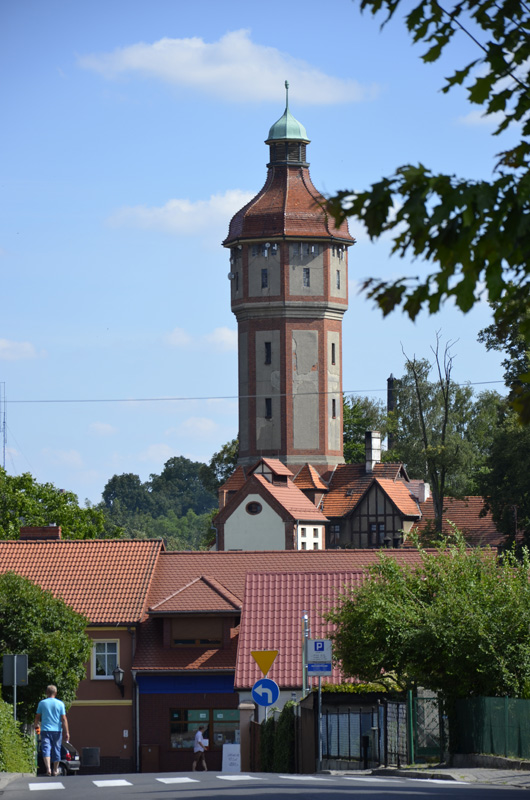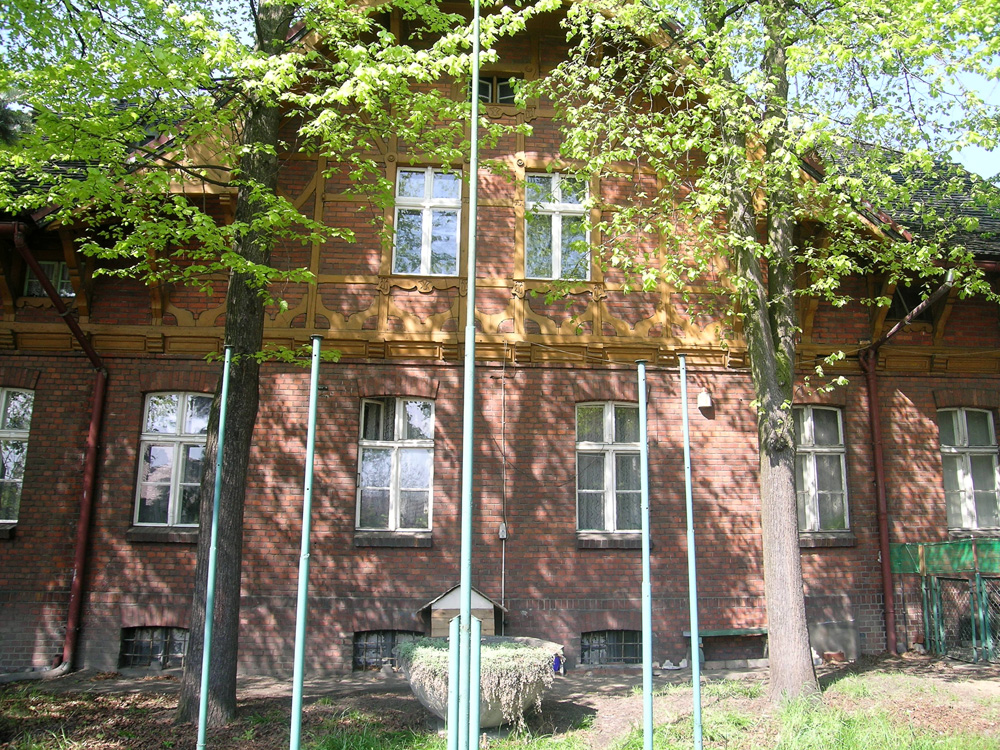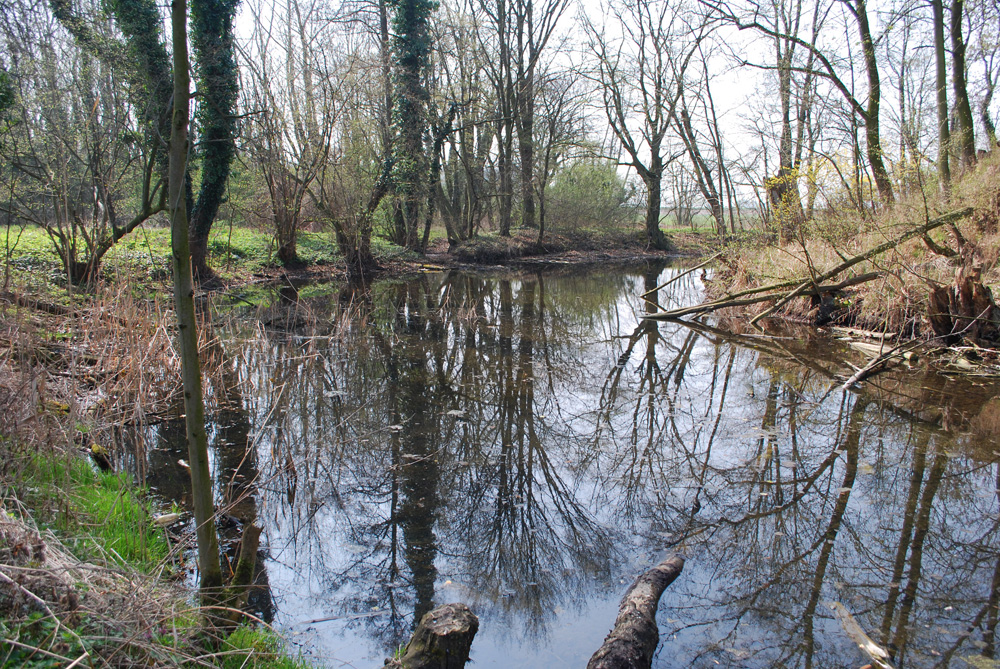
  .jpg) .jpg) .jpg) |
Windmills
Location: Śmigiel, ul. Kościańska
The windmills, with their own legend, are an integral part of the Śmigiel landscape. The legend states that back in the day, there were 99 windmills and when the construction of the 100th windmill was about to be completed, one of the remaining windmills was destroyed in a fire or collapsed under the load of wind. Today, two monumental tower mills standing on the hill at the entrance to the town, coming from Poznań, remind people about past traditions. Serwacy and Pankracy (names given to the windmills), were placed on the existing hill in 1980. They were transported from Bronikowo and Kluczewo, where they were standing previously. The original retained elements include: the towers, shafts, wheels, some of the beams as well as the milling stones. The oldest parts of the windmill from Bronikowo come from the beginning of the 18th century, while one of its elements includes the inscription of the surname of the owner, i.e. Hoffmann and the date, 1726. Śmigiel is a special place in the Windmill Route of the Greater Poland Region while Bonifacy and Pankracy are two of its pearls. It also worth to mention a windmill which is retained in Brońsk and comes from 1889. The windmills are opened occasionally, during field events organised on the windmill hill when occasional exhibits of paintings and sculptures etc. are available to the visitors. Each year, every last Saturday of May, events related to celebrating Śmigiel Day are organised at the windmills. Groups interested to visit the windmill interiors on business days, please make an appointment with an employee of the Śmigiel Town Hall. Contact telephone no. to the Town Hall: 0048 65 5180 003 e-mail: Ten adres pocztowy jest chroniony przed spamowaniem. Aby go zobaczyć, konieczne jest włączenie w przeglądarce obsługi JavaScript. |

   .jpg) .jpg) |
Narrow gauge railroad in Śmigiel
Location: stacja ŚKW w Śmiglu, ul. Dworcowa
The Śmigiel Narrow Gauge Railroad System is an example of a unique railway system in the contemporary landscape. It was a common means of local transport at the beginning of the 20th century. It is also one of the few examples of engineering, technology and construction from that period. This is proven by the infrastructure which is nearly entirely retained and consists of the station buildings from the beginning of the 20th century, the locomotive depot from the days of commissioning the railroad system as well as the tracks which still function today. The system is listed in the register of monuments. The train, which today offers only tourist rides, is operated by the Communal and Housing Management Department in Śmigiel. The offer includes rides upon special order, occasional rides, including Easter and Christmas rides with attractions, annual open rides, visits to the locomotive depot and the train dispatcher room, rides with hand-lever draisines. The narrow gauge railway system includes fully operating machines, i.e.: two LXD2 type locomotives, three MBXD2-type railway cars, two railway passenger cars, three tourist cars, a caboose, transport cars, a few coal transport cars and covered cars, snow plow, fuel draisine, two hand-lever draisines, a tamping machine and forest cars. Since 2004, an Association of Friends of the Śmigiel Narrow Gauge Railway System has been operating in Śmigiel. The friends of the Śmigiel narrow gauge train decided to establish an official organisation, to be able to apply for additional means enabling to undertake activities aiming at supporting the train. The main direction of the Association is popularising and promoting the train as the cultural legacy of Śmigiel through the implemented projects. Hence, the Association organises an open event each year in September for the residents of Śmigiel and fans of narrow gauge railway systems. Detailed information relating to the offer, rides and prices can be found at www.kolejka.smigiel.pl Contact telephone no.: 0048 65 5180 037 e-mail: Ten adres pocztowy jest chroniony przed spamowaniem. Aby go zobaczyć, konieczne jest włączenie w przeglądarce obsługi JavaScript. |

 .jpg) .jpg) .jpg) |
Archeological station in Bruszczewo
Location: Bruszczewo, ul. Przysiecka
In Bruszczewo, a village located 5km from Śmigiel, hidden are the remains of a defensive settlement from the beginning of the Bronze Age. This place is of specific importance for the European archeology and is one of the most recognisable archeological stations from our region in the world. The remains of the settlement were discovered already in 1943, but the excavation research began only in the 1960s. The research was re-launched in 1995 as a joint undertaking of the Poznań Archaeology Museum and the Prehistory Institute of the Adam Mickiewicz University. From 1999, German scientists also participated in the research. Archeologists completed the field research works on the station in Bruszczewo in 2008. Currently, Bruszczewo features information boards with details about the valuable finding while at the Poznań Archaeology Museum tourists can view the items discovered in Bruszczewo. The station itself has again been covered by a thick layer of soil so that in a few dozen years, scientists can return to conduct research using new methods and technologies. |

 .jpg) .jpg) |
Jewish Lapidarium
Location: Śmigiel, ul. Skarzyńskiego
At the end of the 20th century, a few dozen fragments of graves were found coming from the Śmigiel-based Jewish cemetery, a necropolis established in ca. 1785 where the last funeral took place in 1937. The cemetery was destroyed during the Second World War by the German occupation. The surviving Matzewas, which only until recently served as floor tiles in the yards and utility buildings, were restored to their original place in 2008 and were installed at Skarzyńskiego street in Śmigiel and fenced off using the same fence which protected the Jewish cemetery before. The lapidarium ,created in this way, should protect this wealthy history of the town from being forgotten in order to show respect to the former residents of Śmigiel. The Jewish community reached the windmill town in the second half of the 18th century. The turn of the 19th century was a period when the Jews constituted a significant share of the Śmigiel community, amounting to nearly 20%. In 1843, Śmigiel was inhabited by the largest community of Judaists, i.e. as many as 357 people. In its prime, the Jewish commune owned a synagogue in the town (the building no longer exists, it was located in the yard at today’s Mickiewicza street) and a cantor house, apart from the above-mentioned cemetery with a mortuary, a gravedigger house. Also a Jewish elementary school operated in the town. The last Jewish woman living in Śmigiel, left the town in autumn of 1939. Apart from the lapidarium, the premises of the former Jewish cemetery also feature an obelisk dedicated to the residents of Śmigiel who were shot to death in September and October 1939. This was the first place where they were laid to rest. The bodies of the casualties were exhumed in 1945 and moved to the parish cemetery. |

  .jpg) .jpg) .jpg) |
Gas plant in Śmigiel
Location: Śmigiel, ul. Hm. Łukomskiego
The gas plant building, including the gas tank with the capacity of 400 m3 and the cast iron gas network was commissioned in 1902. The construction of the gas plant, located at the existing hm. Z. Łukomskiego street was financed using the Commune funds. Coal gas, which at that time was facilitated for lighting purposes, was used by 149 households and it supplied 60 local street lights. The increasing demand for gas was the reason that in 1911 a second tank was built with the capacity of 600m3, while in 1920, the furnaces were rebuilt in order to increase their capacity. In 1946 the Śmigiel-based gas plant produced so much gas, that in terms of the capacity, it was ranked as the 56th in the entire country. Two furnaces installed in the 1950 have been retained as well as the entire complex of process equipment for producing coal gas. The production of gas was stopped on November 5, 1984. The facility is a monument listed in the register of the Museum of Technology in Warsaw and is the only facility of this type retained in the Greater Poland Province. Today, the facility is owned by the Śmigiel Commune. Some of the gas plant buildings are used as the seat of the Communal and Housing Management Department in Śmigiel. Contact telephone no. to the Department: 0048 65 5180 037 e-mail: Ten adres pocztowy jest chroniony przed spamowaniem. Aby go zobaczyć, konieczne jest włączenie w przeglądarce obsługi JavaScript. |

    |
Water tower in Śmigiel
Location: Śmigiel, ul. Powstańców Wielkopolskich
The water facility with the tower was erected between1912-1913. A tank with the capacity of 125 m3 was transported from Berlin in parts and was joined on site. The tower is 49 meters-high while the tank bottom is located at the height of 26 m. The initial capacity of the water facility was at the level of 600 m3 of water per day while the length of the pipeline network was 13 km. The water facility was modernised in 1964 where new filters and electric pumps were installed. The earlier pumps were gas-supplied. Today, the tower carries an auxiliary function at the modern tank with the capacity of 400 m3 built beside the tower in 2009 and equipped with a filter and pump station. |

    |
A monumental stone at the Mrs. General Barbara Chłapowska-Dąbrowska Park
Location: Śmigiel, park im. Barbary Chłapowskiej pomiędzy ulicami: Reymonta i Lipową
At the park, in the place where the family home of Barbara Chłapowska-Dąbrowska stood, the wife of the famous General Jan Henryk Dąbrowski, the character appearing in the Polish national anthem, a huge stone is placed where memorial plates were installed. The first plate, installed from Reymonta street present Barbara’s image prepared in the form of a medaillon while the second plate, installed on the opposite side of the stone, presents the Chłapowski Family manor house, which does not exist anymore. The memorial plates were uncovered on May 2, 2008. On the same day, a plate with the name of the park was uncovered baring the name of Barbara Chłapowska. The stone to which granite plates are attached, was excavated at the gravel pit in Nietążkowo and is a gift for the town from the pit’s owner, Stanisław Rybakowski. The dimensions of the stone are impressive – in the widest point it is 9m in circumference. |

 .jpg) .jpg) .jpg) |
Evangelical cemetery with a chapel in Śmigiel
Location: Śmigiel, ul. Reymonta
The cemetery is located at the intersection of Kościańska and Reymonta streets. It has an area of more than 1 ha and it was established in 1595. The buildings of the chapel and the gravedigger house still exist today. They were built in 1846. Also, the wall fencing off the cemetery as well as the viewing terrace were developed in mid-19th century. The last funeral here took place in 1959 while in 1974, by means of the decision of the Provincial Office in Poznan, the necropolis was closed. Today, only a few remains of the past graves are still there. There’s also a monumental stone which was placed there in 1905 in celebration of the 300th anniversary of establishing an evangelical commune in Śmigiel. Currently, occasional concerts and exhibits are organised at the chapel. In 2003, the facility was listed in the register of monuments. |

.jpg) .jpg) .jpg) |
Town hall building in Śmigiel
Location: Śmigiel, pl. Rozstrzelanych
The building of the existing town hall located in the town square of Śmigiel (Plac Rozstrzelanych) was purchased in 1832 from a private owner and adopted as the seat of the town’s authorities. The previous building, located in the south part of the market burned down in the large fire of the town in 1814 together with the local archives. The today’s appearance of the town hall is a result of rebuilding works which were completed at the beginning of the 20th century. The building carried the function of the seal of self-government authorities until 1955. At that time, the administration was transferred into the building of the former municipal court at Plac Wojska Polskiego – the existing seat of the Śmigiel administration. During the German occupation and after the war, a museum was housed on the upper storey of the building. The museum exhibits were completely removed from the town hall at the beginning of 1964. Today, the ground floor houses a wedding hall of the Civil Registry Office. |

.jpg) .jpg)  |
Brewery in Śmigiel
Location: Śmigiel, ul. Leszczyńska
The high quality of spring water in Śmigiel was the reason why the brewing industry was developed in the town. The buildings at Leszczyńska street are the remains of the last plant producing beer on the territory of Śmigiel. What should be noted here, is that the first information about the brewing industry in Śmigiel dates back to 1576 and states that brewers guild existed here. The brewery at Leszczyńska street (formerly A. Mickiewicza street) was built in 1894 upon order of a German citizen originating from Bavaria, i.e. Leonard Büchner. It started its operations in 1894 under the name of: Zakład Przemysłowy “Browar Bawarski” (Industrial Plant “Bavarian Brewery). The buildings belonging to the brewery include: administration and residence building designed in the Bavarian style, production plan, malt shop and ice shop which is worth noticing. The ice shop was erected in 1901. It’s 30 meters-high and features a basement with the depth of 10 meters which was equipped with walls with thickness of 1 meter. The cool temperature was provided by ice transported from the Eggelssee ponds in the winter. Initially, light beer was produced here as well as malt and lemonade. Since 1972, the brewery launched production of “Tonic Water” known in the entire country. Over the years, the owners of the plant changed. From 1992 the plant transformed into a company with shareholding of at “Lech” Browary Wielkopolskie (Greater Poland Brewery). The company closed its business in 1998 while the assets of the brewery were sold to an individual entity in 2001. From that moment on the brewery does not operate while the empty buildings remain in possession of an individual. The facility is not available for tours. |

 .jpg) .jpg) .jpg) |
Evangelical cemetery in Robaczyn
Location: Robaczyn
The cemetery was established in 1789 by the Carl Aleksander Bojanowski and his wife, Eleonora Bojanowska nee Bothmer, the owners of Stare Bojanowo, Robaczyn and Nietążkowo. The cemetery with the area of 0.43 ha is surrounded by a wall fence. At the entrance, on both sides of the wooden gate where the establishment date and the name of the founders was engraved, there are two masonry chapels (mausoleums) covered with wooden shingles. In one of the mausoleums, the remains of the two-sided grave of the Bojanowski family and their four children were recovered. Today, a few graves can also be viewed at the cemetery, including the grave of Erdmann Gernoth, the owner of the assets of Stare Bojanowo who has been honored with a Cross for his participation in the Franco-Prussian war in 1870-71. The cemetery was used until the end of the Second World War by the evangelical commune in Stare Bojanowo. In 1957, the cemetery was listed in the register of monuments. Its latest restoration took place in the 1960s. |

   |
Manor House in Nietążkowo and the water tank
Location: Nietążkowo, ul. Dudycza
The residence complex on the premises of which there’s a Post-Middle-School Complex in Nietążkowo, dates back to mid-19th century. The building was erected by the Biron family most likely in the place of the large palace, built in the 18th century by the Bojanowski family, the owners of Nietążkowo and Stare Bojanowo at that time. In the park beside the manor house, an old lime tree grows. There’s also a water tank with a clock which dates back to approximately 1800. Both the tank and the tree come from the times where the palace still stood in Nietążkowo. At the beginning of the 20th century, the Nietążkowo-origin assets were acquired by the Prussian Colonisation Commission. At that time, the manor house and a part of the farmstead were officially adapted for education purposes and still carry this function today. The first education facility in Nietążkowo was the School of peasant women, functioning at the manor house already in the 1890s. This school ceased its activity in February 1936. A year after, a Rural University in Nietążkowo was opened in the building of the manor house. At that time, the University was named after Jan Kasprowicz. As the Second World War started, the University ceased its activity and in its place in 1940 the occupational authorities organised a camp for German girls. Four years later, a labour camp for Poles was established there. Just after the war, a new educational facility was opened in the Nietążkowo-based manor house: the regional household school for girls. In the following years, the education profile at the school was changed quite often: the future accounting employees of the National Machine Centres were educated there as well as electricians and farmers. The big revolution at the school in Nietążkowo took place in 1999 where as a result of the educational reform, the Agricultural School Complex in Nietążkowo was handed over for management of the Kościan district and from September 2001, after another reform, the Vocational School Complex in Nietążkowo was established after joining the General Vocational School in Śmigiel with the Agricultural School Complex in Nietążkowo. A year after, the school changed its name again and became the Post-Middle-School Complex which operates to this day. Both, the village of Nietążkowo and the manor house, where the school is seated are associated with the history of the large number of Arians who lived in these areas in the past. The owners of the Nietążkowo goods include the Cikowski and Arciszewski family. A fun fact is that on May 30, 1812, Napoleon rode through Nietążkowo while on his way to Poznań. |

 .jpg) .jpg) .jpg) |
Palace in Morownica
Location: Morownica, ul. Kaźmierczaka
This large palace in Morownica was erected in 1884 by the Caesar family from Germany according to the design of a Berlin-based architect, Otto Marach. This building made of red bricks and decorated with many details, is a part of the palace project to which two outbuildings and the park also belong. Currently, the palace is owned privately. Apart from the residential complex, there’s also a farm complex which includes the buildings of the horse stable and carriage shop, the sheepfold, granary, stable and a malt shop as well as the houses of the farm employees. Today the farm complex is owned by the Agricultural Production Cooperative in Morownica. The facility does not offer tours. |

 .jpg) .jpg) .jpg) |
Manor House in Stara Przysieka Druga
Location: Stara Przysieka Druga
The manor house in Stara Przysieka Druga contains a residential part and a farm part. The manor house was erected in the 18th century by the abbots from Przemęt who owned the village from as early as 1278 to 1797. The adjacent park features a grave from 1864 founded by the then-owner, Edward Potworowski after the death of his son, Roman. From 1882 the Kurnatowski family owned the assets from that area until the Second World War. The manor house features two outbuildings, a horse stable and auxiliary facilities, including a granary, barns, stables a malt shop and residential houses. Currently, the manor house is a private property and does not offer tours. |

 .jpg) .jpg) .jpg) |
Palace in Czacz
Location: Czacz, ul. Parkowa
The palace in Czacz was probably erected after 1639. It was rebuilt a number of times. Its current appearance is a result of the last modernisation in 1911-1912, completed by Jan Żółtowski, the owner of the palace at that time. The Czacz assets were owned by the Żółtowski family since 1838, when they were acquired by Jan Nepomucen Żółtowski. The building neighbours with galleries which are joined with the outbuildings by means of gates. Today, a School Complex is located in the palace with an adjacent park. The School Complex includes an Elementary School, a Middle School and a Kindergarten. The facility is owned by the Śmigiel Commune. More information about the history of the palace and the Czacz village itself can be found on the website of the school: www.czacz.pl/o-czaczu |

  |
Manor House in Bronikowo
Location: Bronikowo, ul. Machcińska
The manor house was developed at the end of the 19th century by the Forster family, Germans who owned the village from 1893. In the park adjacent to the manor house, there’s a mausoleum with a damaged grave of Oskar Forster. Nearby the mausoleum, there’s a grave of the Unknown Soldier with a cross with the following inscription: “To the Unknown Soldier, who gave his life for the Country in 1945”. Currently, the manor house is the seat of a School Complex owned by the Śmigiel Commune. |

   |
Knight Gord in Bronikowo
Location: Bronikowo
This is an interesting site located near the manor house settlements – an island where explorers discovered cellars which are partially demolished and covered with greenery. It is unknown what the underground structures were used for but one of theories (unconfirmed with research) is that this may be the remains of a knight gord. |

 .jpg) .jpg) .jpg) |
Palace in Spławie
Location: Spławie
The palace in Spławie was erected in the place of a former manor house which was built in 1608. The form of the palace reflecting the Italian style, was given to this building after its restructuring in 1840. From the manor house only the fireplace decoration was restored with the Bończ Coat of Arms. The palace is surrounded by a park with ponds while in its west part, there’s an 18th century figure of Jan Nepoumecen. Today, the palace and the park are owned privately. Occasional events take place here such as weddings, First Communion parties etc. More information at: www.palacsplawie.pl The farm complex adjacent to the palace is currently owned by the Agricultural Production Cooperative in Spławie. The farm features farmstead buildings such as a horse stable and carriage shop from the 19th century, wan ox stable from 1896 and a 19th century barn and a colony of farm employee houses. |

  |
Manor house in Stare Bojanowo
Location: Stare Bojanowo, ul. Główna
A single-storey building erected in mid-19th century which after its rebuilding, was extended by another storey in 1913. In the 1960s a new wing was erected. A part established at the turn of the 20th century is located adjacent to the manor house. The buildings is surrounded by a complex of structures which used to be the farm buildings whose beginnings date back to the end of the 18th century. At the end of the 19th century, the farm in Stare Bojanowo was owned by Gustav Calixt Biron von Curland, who also owned the entire manor house district in Stare Bojanowo. In 1863 this district was constituted by farms in Pośmigiel, Robaczyno, Olszewo, Sierpowo, Nietążkowo and Stare Bojanowo. In 1913 the Bojanowo assets were purchased by the German family of Gernoths (which leased the facility until that time). This family owned the assets until the end of the Second World War. This facility is not available for tours. |

    |
Palace in Parsk
Location: Parsko
The palace was erected after 1848 on the example of a Berlin villa for Baron Rudolf von Gersdorff. The palace is a private property. A mausoleum belonging to the von Gelsdorff family is located nearby which was built in the 1930s. There’s also a park and a farm complex which includes barns, a sheepfold and houses of the farm employees. The facility is not available for tours. |

    |
Manor house in Żegrowo
Location: Żegrowo
The manor house in Żegrowo, located in a park surrounded by a forest, was erected in the 19th century and then rebuilt a number of times. The farmstead part was retained only as remains. In 1881, Żegrowo was owned by Józef Szołdrski, who also had the assets of Popowo Stare in possession. At that time, on the territory of Żegrów, a malt shop and a steam mill were operat The first trout fish farm in the Greater Poland region was established. Currently, the manor house carries the function of a home for a few families. Nearby the manor house, there are oaks with sizes which qualify them to be natural monuments (more information about the trees in Żegrów can be found in the Natural Monuments section). |

    |
Palace in Wonieść
Location: Wonieść
The palace in Wonieść located by the lake, was erected in 1900 by Justus von Wedemeyer. In the past, Wonieść belonged to the Benedictine Convent in Lubiń. The convent members owned it until 1797, and then from 1799 to 1803 it was owned by the von Beyer family. In 1803, the property was acquired by Franciszek Bojanowski. Ludwik von Wedemeyer was the next owner, whose family possessed the Wonieść assets until the end of the Second World War. Currently, a division of the Oskar Bielawski Provincial Neuropsychiatric Hospital in Kościan is seated on the premises of the palace. A large park is located adjacent to the palace. |

 .jpg) .jpg) .jpg) |
Assumption of Mary Parish Church in Śmigiel
Location: the crossing of Farna and Kościuszki streets. Location: Śmigiel, skrzyżowanie ulic Farnej i Kościuszki
The first church here was erected ca. 1443 from the foundation of a Pozan-based bishop, Andrzej from Bnin. The church was destroyed by fire three times and rebuilt each time. In 1907 a tower was added. Inside the church it is worth seeing the Baroque style baptismal font from 1700 and the grave of Urszula from Wielka Wieś Brzeźnicka made of marble and sandstone, a lady who co-financed the rebuilding of the church after the big fire in 1582. The grave was put here by her husband, Kacper Jaruzel Brzeźnicki in 1617. |

 .jpg) .jpg) .jpg) |
St. Vitus church in Śmigiel and catholic cemetery
Location: Św. Wita Street. Location: Śmigiel, ul. Św. Wita
This structure was erected in 1769 in place of a wooden shrine which used to be a parish church in the past (probably in 1200). The church is located on the premises of the cemetery and mainly funeral services take place there. A valuable monument inside the shrine at the main alter is the late-Gothic triptych carved in lime wood in 1506. Its enclosure dates back to 1645. Another item worth seeing is the sculpture of St. Anne with Mary located at the side alter which comes from 1506. The cemetery features a monument of casualties of the Hitler terror. Bodies of 23 people shot and killed at the Market in Śmigiel on 30 September and 23 October 1939 are rested in the grave. In 1945, they were exhumed and transferred to the Jewish cemetery, the place where they were put to rest initially. The cemetery also features a grave of the Wielkopolski Insurgents which was founded by the Association of Insurgents and Soldiers in Śmigiel in 1928. In the oldest grave on this cemetery such people as Aleksander Otto Trąbczyński were laid to rest, an officer of the November Uprising in 1831. He passed away on September 17, 1871. |

    |
St. Stanislaus Kostka Parish Church in Śmigiel (post-evangelical)
Location: skrzyżowanie ulic: Matejki i Szkolnej Location: Śmigiel, skrzyżowanie ulic: Matejki i Szkolnej
It was erected in 1830 by the Evangelical commune. 39 years later a tower was added. In 1946 the shrine was acquired by the Roman Catholic church. Until 1976 the church was a branch of the local Assumption of Mary Church in Śmigiel. In 1976, a new parish was separated from the existing one – the St. Stanislaus Kostka Parish and the shrine became a parish church. More information about the church can be found on the parish website: http://stkostka.smigiel.eu/index.php?option=com_contentHYPERLINK |

  |
Bartholomew the Apostle Parish Church in Stare Bojanowo
Location: Główna street – located on the premises of the cemetery Location: ul. Główna – położony na terenie cmentarza
The exiting shrine was erected in 1849. The tower was added 51 years later. Sources quote that the church structure was already present here in 1389. The church is surrounded by a parish cemetery. The presbytery buildings from the beginning of the 20th century are attached to the walls of the cemetery. More information about the church can be found on the parish website: http://www.parafiastarebojanowo.pl/historia |

  |
St. Teresa Parish Church in Stare Bojanowo (post-evangelical)
Location: Główna street Location: ul. Główna
The shrine belongs to Bartholomew the Apostle Parish Church. It was erected by the evangelists in 1905. It was transformed into Catholic church in 1945. |

    |
Michelangelo Parish Church in Czacz
Location: 27 Stycznia street Location: ul. 27 Stycznia
The church was built in the first half of the 14th century. The tower was erected in 1682. The shrine was rebuilt a couple of times, the last being in 1653. Inside, there are three masonry alters from 1798. The pulpit is from the same year while the baptismal font from the third quarter of the 18th century. Nearby the church there’s a parish cemetery and a chapel from the beginning of the 19th century. More information about the church can be found on the parish website: http://www.parafiaczacz.pl/oparafii_4.html |

  |
St. Lawrence Parish Church in Wonieść
Location: Wonieść
The building was erected in the 15th century. It was thoroughly rebuilt in the 17th and 18th centuries. The polychromies from the church interiors come from 1887-1890. An epitaph board of Anna Ludwika Skarżyńska is installed in the shrine wall. It was made of stone in 1845. More information about the church can be found on the parish website: http://www.woniesc.archpoznan |

 .jpg) .jpg) .jpg) |
All Saints Parish Church in Stary Białcz
Location: Stary Białcz
The existing church was erected at the turn of the 16th century founded by Franciszek Wacław Gajewski. The previous two wooden shrines located in Stary Białcz were destroyed in fire. The first one in 1630 while the second one, which was replaced by the current church, was destroyed at the end of the 17th century. In 1872 a chapel and a bell-tower was erected. More information about the church can be found on the parish website: http://www.parafiastarybialcz.pl/kontakt_7.html |

    |
St. Francis of Assisi Parish Church in Bronikowo
Location: Bronikowo, ul. Morownicka
The only wooden church in the Śmigiel Commune erected after the fire in 1738 on a stone foundation. The chapel was built two years before the start of the Second World War. There are many interesting monuments inside the shrine. The main alter with sculptures and the painting of the Mother Mary with Child dates back to 1700. The side alters with the sculptures and the painting of Adoration of the wounds of Christ dates back to 1704. The second alter with the painting of St. Francis and sculptures dates back to 1698. The historical value is also attributed to the 18th century pulpit and the baptismal font as well as the confessional from 1672. |


 .jpg) .jpg) .jpg) .jpg) |
Marketplace in Śmigiel
Location: Śmigiel, ul. Skarzyńskiego
The marketplace takes an area of 2.5 ha while the remaining area of 0.5 ha is used for parking purposes. The paved part (laid with setts) features more than 430 trade spaces. The remaining area (unpaved) features an additional 20 spaces. Wednesday is the market day. Every week the stalls take most or even all of the spaces. Every week the marketplace is visited by hundreds of customers. Here you can buy such products as: groceries, garden products, household cleaning agents, bicycles, furniture, toys, jewelry, perfumes, tools but the majority is constituted by clothes and footwear. Apart from the Poles, goods are offered by a large group of people from other countries, mainly from Bulgaria. The marketplace has been functioning for a long time in the existing area but the intensified interest of customers and sellers started in the 1990s. The number of sellers increasing year by year made the government take a decision to thoroughly modernise the marketplace. The communal authorities spend nearly PLN 1.4 million in total for the above investment. The trade fees are determined by the Council by means of a resolution. A one-day fee for a single trade space on the paved part of the marketplace depends on the product range of the seller. In order to better facilitate the marketplace, not only once a week, the town authorities made additional initiatives, e.g. they made an effort to indicate Saturdays to be trade days or to organise an automotive marketplace. Unfortunately, neither of these ideas were adopted. The trade Wednesday is still very popular among the sellers and the customers. The market area, apart from the trade purpose, is also used for field events. The residents and the self-government authorities gather here for New Year’s Eve. In a 2-year cycle, Śmigiel also organises Folklore meetings while the Autumn Meetings of Concert Bands are organised later in the year. At such times, the market area is very busy and music can be heard. The marketplace is available every Wednesday from 7am to 1pm. |

 .jpg) .jpg) |
Shooting Range of the Shooting Brotherhood of the Rooster
Location: Śmigiel, ul. Kościuszki
A Shooting Brotherhood of the Rooster operates in Śmigiel which owns two shooting ranges: an outdoor one and one located indoors, at the seat of the brotherhood. In their collections, the brethren have a monumental black powder pistol, sports pistols and pneumatic guns. Visitors can have a try at the shooting range upon supervision of the brethren. The history of the Shooting Brotherhood of the Rooster in Śmigiel dates back to the 15th century. After a break in the Brotherhood’s operations caused by the events of the Second World War and the political situation which occurred after the war, the Brotherhood was reactivated in 1992. Contact tel. number to the Shooting Brotherhood of the Rooster in Śmigiel: 697 909 662 |

 .jpg) .jpg) |
Market place of used items in Czacz
Location: ul. Wielichowska
The “Flea market”, colloquially referred to as the “displays” or the “used stuff market” is located in Czacz, a village which is 2 km away from Śmigiel. Buyers from more distant regions of Poland come to Czacz for the purpose of the market place. The customers are attracted by the broad range of used items imported from the west. Prices can be negotiated. An advantage is also the impressive number of more than 100 outlets located along 2.5km of one of the roads. The offer of the “used stuff” is unlimited. Sometimes, you can purchase a whole range of used appliances, furniture, TV and household devices, carpets, lamps, pictures, bicycles, toys, ceramic products, jewellery and even ceramic stoves and automotive parts. The blooming trade of used stuff sellers on a village road was also the reason that the gastronomic industry developed there – fast-food restaurants as well as ice-cream and waffle shops were opened. Czacz is the busiest between Friday and Sunday – this is when deliveries are made to the outlets. Whole families come here to shop as well as famous people who often drive from distant places of Poland. The customers of used stuff include people from Poznan, Krakow, Wroclaw, Silesia as well as people from Germany. Wholesalers from the area of Wadowice, Warsaw and even Rzeszów are permanent visitors of this market place. Fast-food restaurants are located on the road where the “displays” are presented. |

Sources:
- „Przyczynki do dziejów Nietążkowa” (Contributions to the History of Nietążkowo), Hubert Zbierski, Kościan 2007, publishing house: Towarzystwo Ziemi Kościańskiej (Kościan Asssociation),- „Majątki Wielkopolskie TOM V Powiat Kościański” (The Assets of the Greater Poland Region, VOLUME 5, the Kościan Region), Jolanta Goszczyńska, 1998, publishing house: National Museum of Agriculture and the Farm and Food Industry in Szreniawa,
- „Śmigielskie abc... Przyczynki do dziejów Miasta” (The ABC of Śmigiel… The contributions to the history of the Town), Hubert Zbierski, Śmigiel 2010, publishing house: Śmigiel Town Hall,
- „Zwiedzamy Śmigiel i okolice” (Sightseeing Śmigiel and its surroundings) – A Tourism Monograph prepared by Włodzimierz Kozłowski, Kościan 1993, publishing house: Polskie Towarzystwo Turystyczno-Krajoznawcze (Polish Tourist and Sightseeing Association), Management of the Division in Kościan,
- „Żeby pamięć o niej nie zginęła” (May she stay in the memory), Leokadia Szymanowska, Śmigiel 2008, publishing house: Śmigiel Cultural Association,
- Selected articles from www.ck-smigiel.pl section: History of the region
- Selected articles from www.smigiel.pl
- Wykaz pomników przyrody w Gminie Śmigiel z 2010 (A list of natural monuments in the Śmigiel Commune from 2010): a publication by the Śmigiel Town Hall











